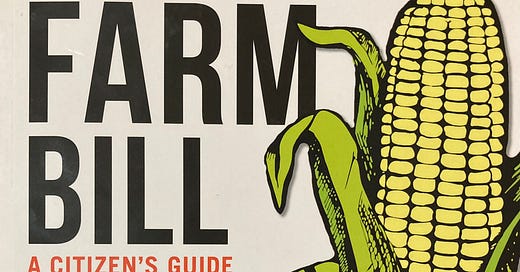The Farm Bill
The newest iteration of the ‘farm bill’ is in the works right now. I’ll admit, I have always been intimidated by it, and yet, I cannot complain about it (though I do regularly) if I am not willing to attempt to understand and advocate for its change.
So, this is the year I aim to be informed.
I bought a book and have bookmarked, even read, some online articles. However, this is hard work for me. My brain was not built for this. Whatever the opposite of a policy wonk is, that’s me. The ‘farm bill’ (the name changes with each new version) is the definition of a juggernaut. It is a force unto itself.
I am about halfway through The Farm Bill: A Citizen’s Guide by Daniel Imhoff. It starts by laying out the history of the farm bill, including attempts to reign it in and having it balloon out of control instead. I am just starting “Part IV: Reforming the Farm Bill.” I invite you all to read along with me. Part V is titled “The Future of Food Policy.”
It is fair to question the farm bill, especially where the funds are being allocated in. The largest portion of the farm bill, about 80 percent, is dedicated to SNAP (Supplemental Nutrition Assistance Program) and that is important. In her excellent article, The Farm Bill Drove Me Insane, Marion Nestle demonstrates allocation as it would appear on our plate:
“The guidelines do, however, suggest eating more fruits and vegetables, advice that the USDA repeats in its MyPlate good guide for the general public. This guide illustrates the idea that half the plate – 50 percent – should be fruits and vegetables. But USDA’s farm bill policies have historically allocated less than 1 percent of farm support funds for promoting these food, with nearly all of the remaining 99 percent used to support commodity crops….If you were to create a MyPlate meal that matched where the government historically aimed its subsidies, you’d get a lecture from your doctor. More than three-quarters of your plate would be taken up by a massive corn fritter (80 percent of benefits go to corn, grains, and soy oil). You’d have a Dixie cup of milk (dairy gets 3 percent), a hamburger the size of a half dollar (livestock: 2 percent), two peas (fruits and vegetables: 0.45 percent) and an after-dinner cigarette (tobacco: 2 percent). Oh, and a really big linen napkin (cotton: 13 percent) to dab your lips.”
Personally, I am frustrated with the fact that subsidies go to large, monoculture, commodity farms with little-to-no help coming to small farms like mine. These larger operations are growing things that make people and our planet unhealthy, and are rewarded, while we try to provide healthy foods, grow our communities, and care for the land. So many of us barely make ends meet and many end up having to leave the farm and find other ways to make a living.
Financial help during the pandemic, through the PPP and CPAC, gave our farm a financial boost, one we needed. We could use that every year, as I am sure other farms like ours could, to invest in better farming practices, efficiencies, and just to keep things running. What if farmers could take a sabbatical year? Rest the land and themselves? What if there was easily accessible grant funding for solar powered packing sheds and electric tractors?
David is hoping for some more grant opportunities for conservation, ones we were not able to take advantage of when they were offered in 2008, but would hope to now.
What would you like to see included? Taken out?
I don’t think I’ll have enough of a grasp on the juggernaut that is the farm bill this go round, but am trying to inform and educate myself in order to become more involved the next time. I’ll do what I can.
Keep in touch!
-Margaret Ann
Link to committee membership:
https://www.agriculture.senate.gov/about/membership
There are subcommittees listed as well on a link from that page.
Links to more info:
Please share any helpful information you find!




